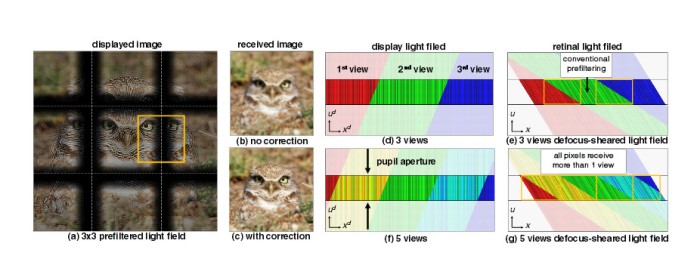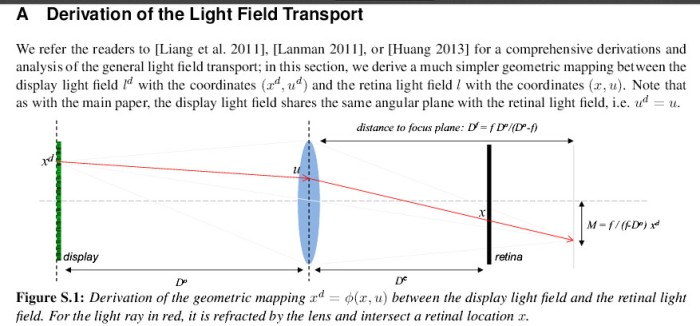This New Display Technology Eliminates the Need for Corrective Glasses
Displays have dramatically advanced over the years. From the already high-end 720p resolution of yesteryears, we are now enjoying ultra high resolution displays for mobile devices that even go beyond the 500 ppi pixel density. We can now enjoy 4K resolution at the palm of our hands with excellent brightness and contrast levels, accurate colors even on OLEDs, and efficient energy consumption. However, there haven’t been major attempts to make these display technologies useful to those with eyesight difficulties. That’s why the new display technology from Berkeley and MIT is definitely a welcome new tech for people who need to put their cumbersome glasses on when reading from their tablets or smartphones.
As presented in a paper prepared by researchers at the Massachusetts Institute of Technology and University of California-Berkeley, a new display has been created employing computational light field technology to correct visual aberrations. The paper was from Fu-Chung Huang and Brian A. Barsky of the UC Berkeley Computer Science Division and Gordon Wetzstein and Ramesh Raskar of the MIT Media Lab. Fu-Chung Huang is also affiliated with Microsoft.
Display Tech for Poor Eyesight
This is one of those technology developments none would probably say anything negative about. If many criticized the seeming senselessness of increasing the number of pixels in mobile displays. Berkeley and MIT scientists are doing something more worthwhile by making mobile displays usable for people with sight problems. This display technology involves the use of a light filter to be placed on top of a display and the modification of the image reproduction algorithms of a device. The light filter here is a slab made of acrylic. This setup does not involve a new panel but a mere software and minimal hardware add-on to already existent devices to make their displays look clearer to people with blurry vision.

Cropped screenshot from the UC Berkeley paper “Supplementary Material:
Eyeglasses-free Display: Towards Correcting Visual Aberrations
with Computational Light Field Displays”
How Does It Work
This technology works through algorithms that modify an image based on a person’s glasses prescription. Obviously, the wearer needs to have his or her eyes checked first to implement the necessary configurations. The light filter changes the light that represents each individual pixel of an image so that the light becomes clearer and sharper when it reaches the retina.
This is basically similar to how corrective eyeglasses work. The filtered and modified display projects images that have been processed based on the prediction of how the (defective, degraded) eyes will distort images. Hence, things start looking good to the wearer’s eyes. It’s basically distorting images to compensate for the distortion that happens on the defective, impaired, or degraded eyes.
To test the effectiveness of this new display technology, the researchers used an iPod Touch. They attached the light filter and did the necessary changes on the image reproduction. They used a DSLR camera to simulate (through the focus options) the visual perception of people who are nearsighted or farsighted. They successfully showed how it can be possible to let people with less than perfect vision enjoy their smartphones or tablets without the need for eyeglasses.
Applications
This display technology is expected to be used not only on smartphones, tablets, and other mobile devices. However, the research team behind it are still in the process of refining the technology to make it slimmer so it can be used in devices without excessively adding bulk. The software component also has to be developed further to become applicable to other operating systems. The goal is to make the technology non-obtrusive and inexpensive to be used on most handheld devices.
Unfortunately, this display screen technology can’t work on television or bigger displays that will be viewed by multiple eyes. The system only makes things look clear to one user who views the display straight on. It only works with a specific position. As such, for now, it can only be used with handheld devices and personal computers or laptops. Further work will be needed for it to become useful in the living room television. The researchers have not tried actually using the technology on a big screen TV. However, it is expected that it will work with only one viewer.
According to UC-Berkeley professor Brian Barsky, the project lead researcher: “People with higher order aberrations often have irregularities in the shape of the cornea, and this irregular shape makes it very difficult to have a contact lens that will fit.” He adds that “this research could transform their lives.”

Cropped screenshot from the UC Berkeley paper “Supplementary Material:
Eyeglasses-free Display: Towards Correcting Visual Aberrations
with Computational Light Field Displays”
Other display technologies similar to this have been attempted. However, the technology developed by Berkeley and MIT researchers stand out for offering something that does not result in the significant loss in image contrast. It also works with higher resolutions, something that will be suitable to the kind of resolutions many mobile devices currently sport.
![By Armchair (Own work) [CC0], via Wikimedia Commons](https://techtheday.com/wp-content/uploads/2014/08/prescription-glasses.jpg)